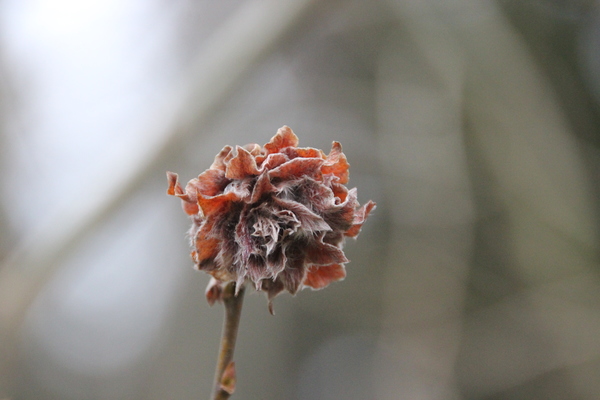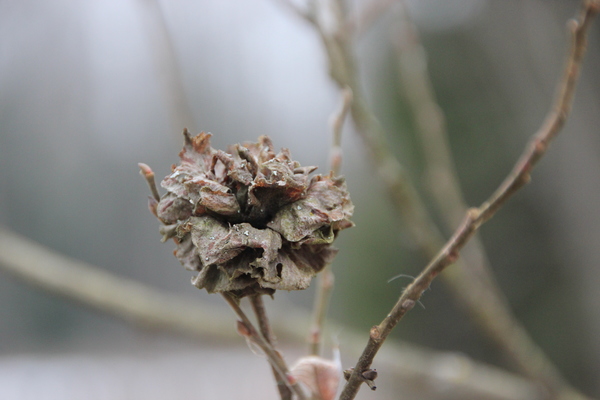Willow "Roses" - Magic Created by Nature
When deciduous trees and bushes are not yet green, it is easy to notice peculiar formations - willow "roses". Here and there they even stand out conspicuously on branches. In spring, "rose flowers" have lost a large share of their summer prettiness, they have parted from all of their delicate green colours and become brown. In summer, when trees and shrubs are in full bloom, one can stand next to a willow "rose", without even noticing it. To notice these specific "flowers" in the warm season of the year, you have to look carefully into the "jungle" of leaves.
Willow "roses" may be found on plants of the willow family, willow genus. It should be borne in mind that more commonly "willow roses" are to be found on the purple or red willow (Salix Purpurea), the eared willow (Salix Aurita) and the grey willow (Salix Cinerea), but often they decorate the goat willow (Salix Caprea), the crack willow (Salix Fragilis) and the white or silver willow (Salix Alba), less often other Salix species.
It is thanks to an insect that such things can happen. This insect is among the most common gall midges in the Northern Hemisphere - Rhabdophaga Rosaria. This means that the "rose flowers" that are to be found in branches of osiers and willows are actually specific galls - rose flower gall midge nurseries that are made by larvae of these insects to ensure long-term favourable living conditions. A gall created by a gall midge of the rose flower is so specific that it can easily be recognised even by a non-specialist. However, even a professional entomologist may have some hard time distinguishing between adult insects of this species and adult representatives of many other similar species.
Kurš darinājis šos „ziedus”, kas nav ziedi?
Vainīgais ir kukainis – viens no Ziemeļu puslodē izplatītākajiem fitofāgajiem pangodiņiem: kārklu rožzieda pangodiņš (Rhabdophaga rosaria). Tas nozīmē, ka kārklu un vītolu zarotnē atrodamie „rožu ziedi” patiesībā ir specifiskas pangas – rožzieda pangodiņu bērnistabas, kuras šie kukaiņu kāpuri veido, lai nodrošinātu sev ilglaicīgi labvēlīgus dzīves apstākļus. Rožzieda pangodiņa radīta panga ir tik raksturīga, ka to viegli spēs atpazīt pat nespeciālists. Taču pat profesionālam entomologam var nākties pamocīties, lai atšķirtu šīs sugas pieaugušos insektus no daudzu līdzīgu sugu pieaugušajiem pārstāvjiem.
From a small bud to a nature's work of art
In late April or early May, about three-millimetre-long gall midge females one after another rush to lay eggs in buds of the willow plants; later these eggs turn into small larvae. When they are developing, affected by mechanical and chemical reactions, the bud gets deformed - lengthwise growing of its shoot is blocked, while the development of leaves does not stop.
Already in early June, there is a small, yet immature gall, which consists of only a few leaves suggesting that in the middle of the formation there is or has been an offshoot of insects. Until late summer, the larva lives alone in its gall, as it is slowly maturing.
In turn, its maturity "flowers" are on average in the size of a walnut, and consist of 30 to 60 leaves. They can also be considerably larger or smaller, depending on the host species.
Changing along the seasons
In the autumn season, gall-forming leaves wither and take a brownish colour, yet not loosing their attractiveness. It is interesting that they do not split off the branch, but remain together in a rose-like "flower" throughout winter (and sometimes even the entire next summer), providing a safe haven for the couple-of-millimetres-long orange larva.
Young insects that have reached the stage of imago hatch in the middle of spring. They have only a few days at their disposal before the leaves burst to make home in buds to their younger generation, thus continuing the cycle of life.



















